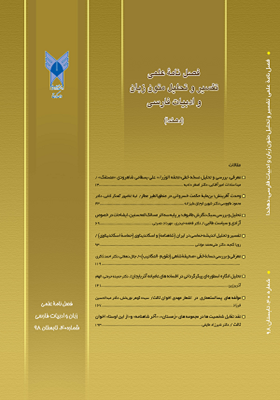تفسیر و تحلیل اندیشه حماسی در ایران (شاهنامه) و اسکاندیناوی (حماسۀ اسکاندیناوی)
محورهای موضوعی : متون زبان و ادبیات فارسیرویا گنجه 1 , علی محمد موذنی 2 *
1 - دانشجوی دکتری زبان و ادبیات فارسی، دانشگاه آزاد اسلامی واحد خلخال،خلخال،ایران
2 - استاد گروه زبان و ادبیات فارسی، دانشگاه تهران،تهران،ایران
کلید واژه:
چکیده مقاله :
فارغ از مسئلۀ تأثیرگذاری و تأثیرپذیری آثار دو سرزمین، میتوان بابی را گشود در موضوعی خاص که از جهت محتوا در آنها وجوه اشتراکی وجود دارد و آن را دستمایۀ قیاس یک موضوع، یک گرایش و یک محتوای ویژۀ مشترک در دو سرزمین مختلف قرار داد. مسئلۀ رویینتنی از نکات پر اهمیت و پر بسامد در تاریخ ادب و اعتقادات سرزمینهای مختلف است که رویی جانب تاریخ و رویی جانب تخیل بشر روزگار پیشین دارد. در این پژوهش بنا داریم تا به بررسی اندیشۀ حماسی ایران و اسکاندیناوی و مشهورترین تجلی این اندیشه در آثار حماسی این دو قوم پرداخته و به بیان وجوه اشتراک و سنجش برتریها و کاستیهای این آثار در مقابل یکدیگر بپردازیم تا به این بهانه، این دو اثر در قابی مشترک به نمایش درآیند و به این واسطه نکاتی چند در باب هر یک با نگاهی دقیقتر آشکار گردد
Apart from influencing and being influenced through the works of two lands, it is possible to go into specific topics which have some points in common regarding the content. The same common points can be used to compare both a topic and an approach as well as a content similar and common in these two different lands. The issue of having a strong body can be considered to be an important factor in literature and beliefs of different lands demonstrating the human history and primitive humans. The current study aims to investigate Iranian and Scandinavian epical thoughts along with the most famous expression of the same thoughts in epical works of these two nations. It also aims to state and compare the commonalities, superiorities, and inferiorities in order to put these two works in the same framework through which we are able to scrutinize each of them in detail.
مقالات
_||_

